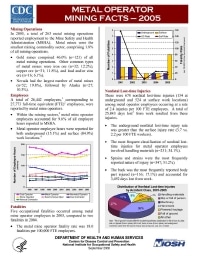Mining Publication: Metal Operator Mining Facts - 2005
Original creation date: September 2008
Authors: National Institute for Occupational Safety and Health
NIOSHTIC2 Number: 20034768
Pittsburgh, PA: U.S. Department of Health and Human Services, Public Health Service, Centers for Disease Control and Prevention, National Institute for Occupational Safety and Health, DHHS (NIOSH) Publication No. 2007-151, 2007 Sep; :1-2
Mining Operations: In 2005, a total of 263 metal mining operations reported employment to the Mine Safety and Health Administration (MSHA). Metal mines were the smallest mining commodity sector, comprising 1.8% of all mining operations. Gold mines comprised 46.0% (n=121) of all metal mining operations. Other common types of metal mines were iron ore (n=32; 12.2%), copper ore (n=31; 11.8%), and lead and/or zinc ore (n=16; 6.1%). Nevada had the largest number of metal mines (n=52; 19.8%), followed by Alaska (n=27; 10.3%). Employees: A total of 26,442 employees, corresponding to 27,773 full-time equivalent (FTE) employees, were reported by metal mine operators. Within the mining sectors, metal mine operator employees accounted for 9.6% of all employee hours reported to MSHA. Metal operator employee hours were reported for both underground (15.1%) and surface (84.9%) work locations. Fatalities: Five occupational fatalities occurred among metal mine operator employees in 2005, compared to two fatalities in 2004. The metal mine operator fatality rate was 18.0 fatalities per 100,000 FTE employees. Nonfatal Lost-time Injuries: There were 678 nonfatal lost-time injuries (154 at underground and 524 at surface work locations) among metal operator employees occurring at a rate of 2.4 injuries per 100 FTE employees. A total of 25,843 days lost from work resulted from these injuries. The underground nonfatal lost-time injury rate was greater than the surface injury rate (3.7 vs. 2.2 per 100 FTE workers). The most frequent classification of nonfatal lost-time injuries for metal operator employees involved handling materials (n=231; 34.1%). Sprains and strains were the most frequently reported nature of injury (n=347; 51.2%). The back was the most frequently reported body part injured (n=116; 17.1%) and accounted for 3,492 days lost from work.

NIOSHTIC2 Number: 20034768
Pittsburgh, PA: U.S. Department of Health and Human Services, Public Health Service, Centers for Disease Control and Prevention, National Institute for Occupational Safety and Health, DHHS (NIOSH) Publication No. 2007-151, 2007 Sep; :1-2
- Coal and metal/nonmetal mining facts - 2008
- Coal and Metal/Nonmetal Mining Facts - 2008 (HTML)
- Coal Contractor Mining Facts - 2001
- Coal Contractor Mining Facts - 2002
- Coal Contractor Mining Facts - 2003
- Coal Contractor Mining Facts - 2004
- Coal Contractor Mining Facts - 2005
- Coal Contractor Mining Facts - 2006
- Mining Fact Sheets
- Rib Falls: A Major Ground Control Issue